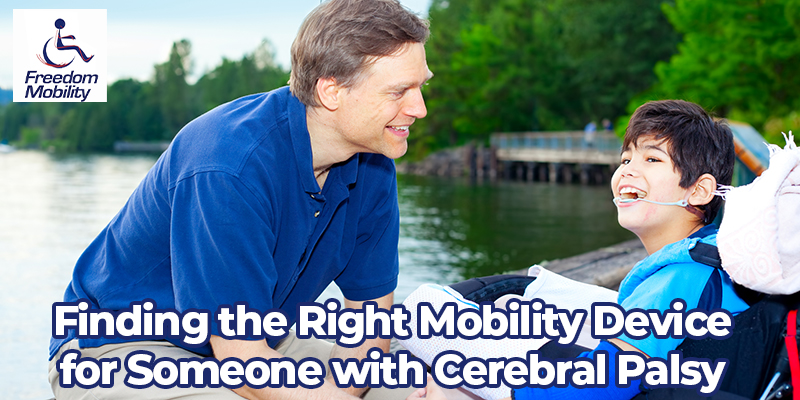Cerebral palsy refers to a whole group of disorders that can appear in early childhood that affect a person’s movement and posture. Depending on the way the disorder manifests itself determines what type and form of cerebral palsy the person has.
Cerebral palsy can also get classified differently depending on the types of doctor they are seeing or which government agency they are working with. Cerebral palsy can get classified as mild, moderate, or severe.
Because cerebral palsy can cause different mobility issues for people, choosing a mobility device for someone with cerebral palsy needs to be considered on an individual basis. The mobility device used needs to provide adequate support and assistance which can make the choice difficult.
Choosing a Mobility Device for Someone with Cerebral Palsy
Figuring out which cerebral palsy mobile device to use will vary depending on the individual person’s needs and the type of cerebral palsy they have. For example, one type of mobility device might work for a short distance. Perhaps another is better for longer trips or when a person needs to do other things while in motion.
Mobility devices can help a child or adult with cerebral palsy to keep as much independence and autonomy as possible.
Hand-Held Mobility Devices
While a bit over half of the children with cerebral palsy can walk independently, 11.3% require the use of a hand-held mobility device. Canes, crutches, and standers are all types of hand-held mobility devices.
Canes can get used by people who have a mild type of cerebral palsy. They can get adjusted to fit different heights as a child grows. Some canes have three or four prolongs at the base which can allow for more support.
Crutches come in three types and get built to provide support at different sections of the body. Crutches can be fit under the arm, under the elbow, or under the forearm. Most cerebral palsy patients use the type that fits under the forearm.
Standers are sturdier than canes or crutches. Standers help support the user’s weight so they can stand up on their own.
Some standards are designed only to allow the user to stand, but there are others who allow for more options, like moving forward. Which type is best for the user will depend on how much head, trunk, and body strength the user has?
Walkers
Walkers can get used by people with cerebral palsy who can walk but needs some assistance to help maintain balance. There are two types of walkers.
One type is anterior which means the walker is used by the person when they are behind the walker. These walkers provide support when the person has trouble with extensor spasticity which can cause them to lose balance and fall backward.
The other type is posterior. These walkers get used by a person walking in front and between the arms of the walker. Posterior walkers can work well for most with cerebral palsy.
Strollers
Strollers that have gotten outfitted with straps to support the chest and waist can help provide the support needed for a person with cerebral palsy. It can keep them sitting upright while the stroller is sitting still or mobile.
Look for a stroller that is adjustable to allow for the footplates to get raised or lowered to the user’s height. Straps can get used to secure the feet in place to keep them safely in place while the stroller is being moved around.
Wheelchairs
Like strollers, wheelchairs are can help aid the mobility of people with cerebral palsy. Like strollers, manual wheelchairs get pushed by their caretaker to transport the rider if they cannot propel it on their own. Power wheelchairs can get directed and controlled by the user.
Wheelchairs can come equipped with supports and straps to keep the rider safe and provide posture assistance. They can also get adjusted over time to accommodate the user’s height and weight when necessary.
Unlike strollers, wheelchairs typically have a storage basket under the seat which basic medical strollers do not.
Complex Power Rehab Chairs
Complex power rehab chairs are another great option for people with cerebral palsy. These chairs come in a variety of designs and have accessories that can get added to help address complex needs.
The suppliers of these chairs can work with the patient’s doctors and therapists to help determine the perfect chair for the individual. They will work to help ensure the chair gets outfitted and adapted to provide the right support to keep the user sitting upright and secure.
These power operated chairs allow the rider to easily control the speed, position, and direction of the chair.
Lifts and Ramps
A body lift, vehicle lift, or a ramp might be needed to allow people with cerebral palsy to take advantage of the chairs listed above. Body lifts are used to assist when the caretakers are unable to move the user into or out of their chair. A vehicle lift or a ramp can be used to transfer a wheelchair or complex power rehab chair into and out of a vehicle.
Order a Mobility Device Today
Choosing the right mobility device for someone with cerebral palsy can be difficult. This is why talking to professionals who have experience helping assist people in finding the right device is invaluable.
Contact us to discuss your individual needs and tell us what you’re looking for in a mobility device. We specialize in helping people find the support they need to live an active and healthy lifestyle.

